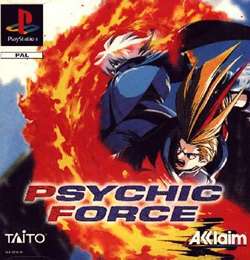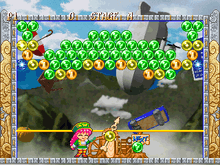Psychic Force
| Psychic Force | |
|---|---|
 | |
| Developer(s) | Taito |
| Publisher(s) |
Taito (Japan) Acclaim (North America, PAL regions) |
| Platform(s) | Arcade, PlayStation, Dreamcast |
| Release date(s) |
Arcade 1995, 1996 PlayStation October 4, 1996 (Japan) April 1997 (North America) July 1997 (PAL region) |
| Genre(s) | Action, Fighting |
| Mode(s) | One-On-One; Up to 2 players simultaneously |
| Cabinet | Upright |
| Display | Taito FX-1 System |
Psychic Force (サイキックフォース Saikikku Fōsu) is a 1995 fighting arcade game created by Taito which was later ported to the PlayStation in 1996 and 1997. The PlayStation version was released by Acclaim in North America, and in PAL regions. The game was a 3D fighter which had combined the normal features of an arcade fighting game with psychic powers. There were eight playable characters available to choose from in the game and a final boss/secret character who is playable through the use of a code. Psychic Force was released without much hype and was not commercially successful at the time of its initial release, but the series has since gained a strong cult fanbase. Psychic Force would later get an arcade-exclusive update titled Psychic Force EX, which was released a year later in 1996. EX would make Keith, the final boss/secret character of the original game a playable character without having to initiate a code and that the characters would receive new color schemes for their costumes while the gameplay was improved and balanced. In 1998, a sequel was released under the title Psychic Force 2012 also for the arcade, and was later ported to the Dreamcast console in 1999. It was eventually adapted to the PlayStation under the title Psychic Force 2, which was released in Japan on October 7, 1999 and later to the PAL regions in 2001.
In 2006, the original Psychic Force was re-released as part of as an anniversary pack for the PlayStation 2 titled Psychic Force Complete, which had included Psychic Force 2012 and a special exclusive remixed version of 2012 titled Psychic Force 2012 EX.
Gameplay
All combat in Psychic Force takes place in a cubic space defined by a magical force field. The fighters float inside this space and are capable of movement in all directions. Even though Psychic Force is structured as a 3D game, the gameplay is in 2D.
The walls of the force field play a big part in the strategy behind Psychic Force. A character takes damage when they're forced into a wall by their opponent. The character do not take damage, however, if they move into the wall themselves. If a character takes another hit as they bounce off from the wall, the character will become stunned and fall through the air. The character is eventually invulnerable while they're falling.
As in most fighting games, the first character to win two rounds wins the match. However, you cannot win a round on time. i.e., if time runs out, neither player wins. Instead, you go to a sudden death round in which the space is much smaller and both characters have 0% Psycho Gauge. The first person to land an attack wins. When you are fighting the computer, however, the character with more health remaining at the end of the round wins.
The characters are controlled with an eight directional joystick and three buttons which dictate a guard, a light attack, and a heavy attack (On the ported PlayStation version these commands were given to the square, triangle and circle buttons). By combining these different commands, the player can make combo attacks, throws, and special moves which can break the enemy's defenses.
A character's special move is determined by the Psycho Gauge, which is seen under the Life Gauge of the character. Depending on the type of special move initiated, the Psycho Gauge will immediately drain from within sight and once the character uses up their entire Psycho Gauge, they'll be left with the only option to unleash continuous weak projectiles until the Psycho Gauge is charged back up, either through an automatic slow charge or a manual fast charge in which the player can press all three buttons to help re-charge their Psycho Gauge.
Other tactics seen from within Psychic Force includes a Barrier Guard, which can be used to help protect a character from both physical attacks and special moves but drains the Psycho Gauge real quickly, an Evasion Barrier, in which the character can immediately put up a force field and avoid slamming against the wall even though it uses up 40% of the Psycho Gauge, a Normal Dash which enables a character to move real quickly in any direction from within sight, and a Quick Dash which enables a character to move real fast towards their opponent while being able to deflect any weak projectile that gets in their way.
In both the original arcade version and home console Story Mode of Psychic Force, the player's character would go through eight stages of combat from within sight against a specific set of opponents and that they would face off against a specific final boss from within the eighth and final stage which would vary and depend from within the specific playing character's story. The home console Story Mode would add additional cut-scenes in order to advance the story of the specific playing character and an ending would be presented once the player is able to beat the game with the specific playing character.
Story
The plot of Psychic Force takes place in the year 2010, where selected individuals are blessed with the power of psychic abilities. All people imbued with this power are called "Psychiccers" and uses a specific element such as fire, light, wind, electricity, gravity, time, or ice in fighting.
Psychiccers are shunned by normal people in general because of their unnatural abilities and that most cases turn violent and deadly from within sight. All of that changes one day when a mysterious Psychiccer organization known as NOA appears and offers Psychiccers a place from within their company. Headed by a young British Psychiccer man named Keith Evans, NOA seeks to create a perfect utopia for Psychiccers and that they'll eliminate anyone who tries to stand in their way.
Challenging NOA's ambition is a small independent group known as Anti-NOA and that one of its members, a young American Psychiccer man named Burn Griffiths, seeks to confront and stop his old friend Keith from going through with his extreme plans of creating a Psychiccer-only world.
Characters
- Burn Griffiths: The main protagonist of the series. A young American Psychiccer man who has the ability to use the psychic power of fire in battle. Burn seeks to find his old friend Keith so that he can convince him to give up his ambition of creating a Psychiccer-only world.
- Emilio Michaelov: A young Russian Psychiccer boy who has the ability to use the psychic power of light in battle. Emilio is very scared of his own ability and only seeks peace and solitude.
- Wendy Ryan: A young Australian Psychiccer girl who has the ability to use the psychic power of wind in battle. Wendy seeks to find her long-lost older sister Chris and suspects that NOA may have the answers to her questions.
- Sonia (Chris Ryan): A young bioroid Psychiccer woman who has the ability to use the psychic power of electricity in battle. While Sonia serves NOA and Keith with undying loyalty, she is actually Wendy's older sister Chris, who was kidnapped and remade into a bioroid by Wong.
- Brad Kilsten: A young German Psychiccer man who has the ability to use the psychic power of gravity in battle. Having a split personality disorder, Brad is unpredictable in battle as his gentle side clashes with his psychotic side.
- Richard Wong: A Hong Kong Chinese Psychiccer man who has the ability to use the psychic power of time in battle. Even though Wong serves as Keith's consultant and strategist in NOA, he secretly seeks to eliminate Keith so that he can advance his own ambition of conquering the world.
- Rokudo Genma: A Japanese Yamabushi [1] monk/priest who uses his own unique style of Shugendo[2] magic in battle. Genma is convinced that psychic power is a double-edged sword and seeks to eliminate all Psychiccers.
- Gates Oltsman: An American cybernetic soldier who relies on his own enhancements in battle. Upon surviving a devastating Psychiccer attack that had taken the lives of his wife Cheryl and their daughter Tina, Gates, who was reborn as a cyborg, seeks revenge against all Psychiccers.
- Keith Evans: A young British Psychiccer man who serves as the leader of NOA and that he has the ability to use the psychic power of ice in battle. Keith's ultimate goal is to create a utopia for Psychiccers and that he'll eliminate anyone who tries to stand in his way.
OVA
In 1998, a two-episode anime OVA was released.
The first episode describes Keith's escape from the laboratory where he was being experimented on. Burn almost hits him with his motorcycle, and takes a frightened Keith home. Three men in dark suits come looking for Keith, who uses his psychic abilities to injure two of them, and chase the third out. When Burn tries to help Keith escape, they are ambushed and, despite Keith's best efforts, he is dragged away, leaving Burn lying on the ground, which awakens his powers.
The second episode features Keith and Burn several years later, where Keith has been taken under the wing of Wong, head of NOA. Keith declares his vision of peace to the world, and begins to round up lost Psychiccers. Burn's dormant psychic abilities are detected by Gates, who tries to attack Burn, but Burn is saved by Keith and Sonia. While Burn is in NOA HQ with Keith, he berates him for trying to start a war between humans and Psychiccers, then leaves with Wendy and Emilio. He eventually heads back to confront Keith, but their fight is interrupted by Wong who triggers the self-destruct for the NOA HQ. Keith traps Burn in a cocoon of ice, leaving him as the only survivor.
Puzzle Taisen

There was also a Puzzle Bobble spin-off game known as Psychic Force Puzzle Taisen, which was released on October 2, 1997 for Sony PlayStation in Japan only.
See also
- Senko no Ronde, a similar game based on projectile attacks and flying characters
- X: Unmei no Sentaku, a similar game
References
External links
- Psychic Force (anime) at Anime News Network's encyclopedia